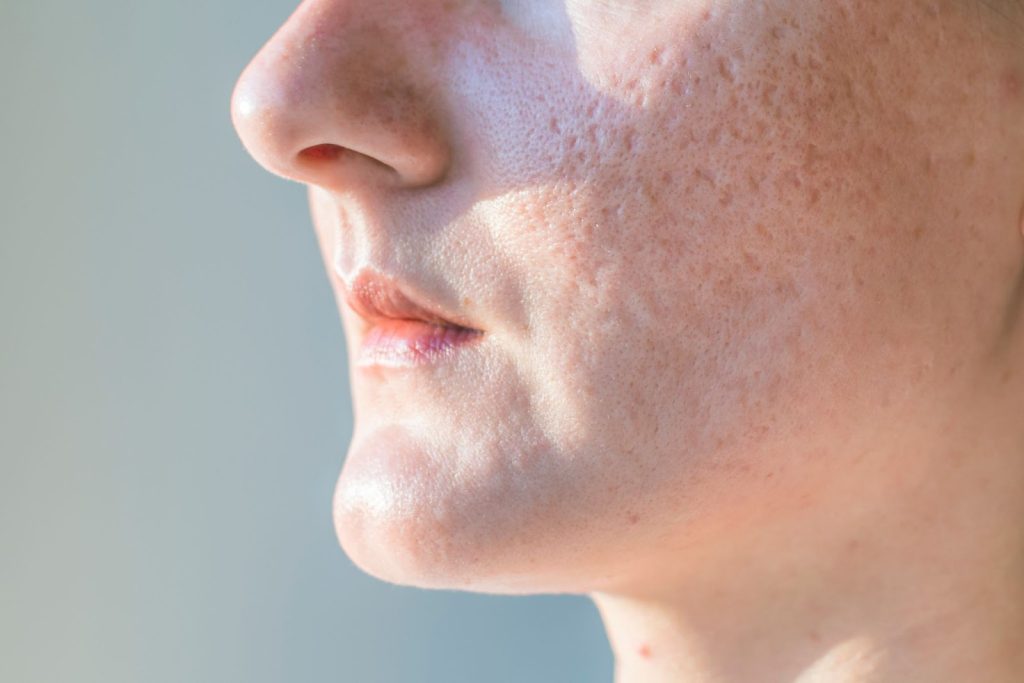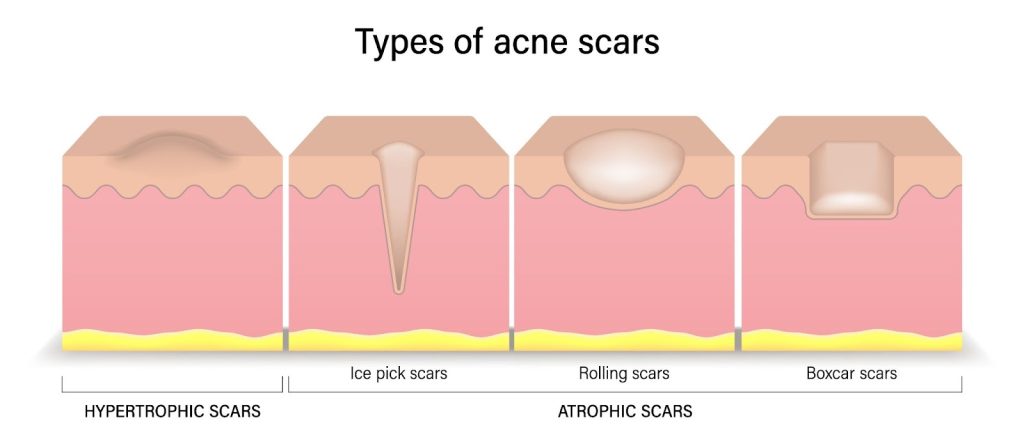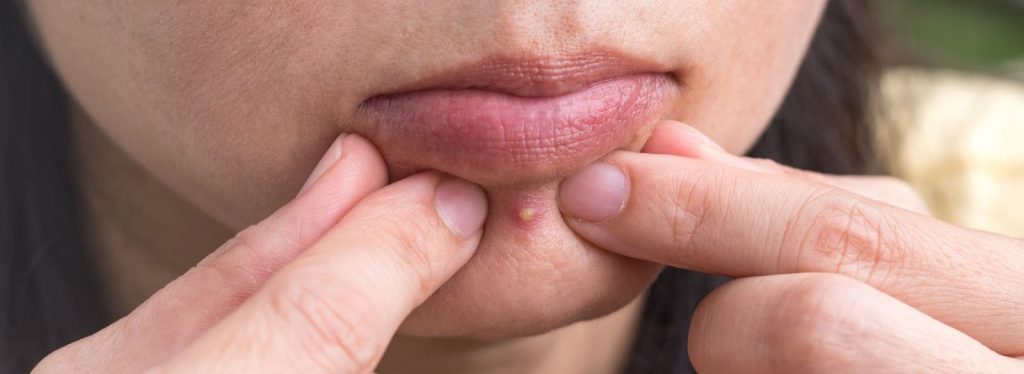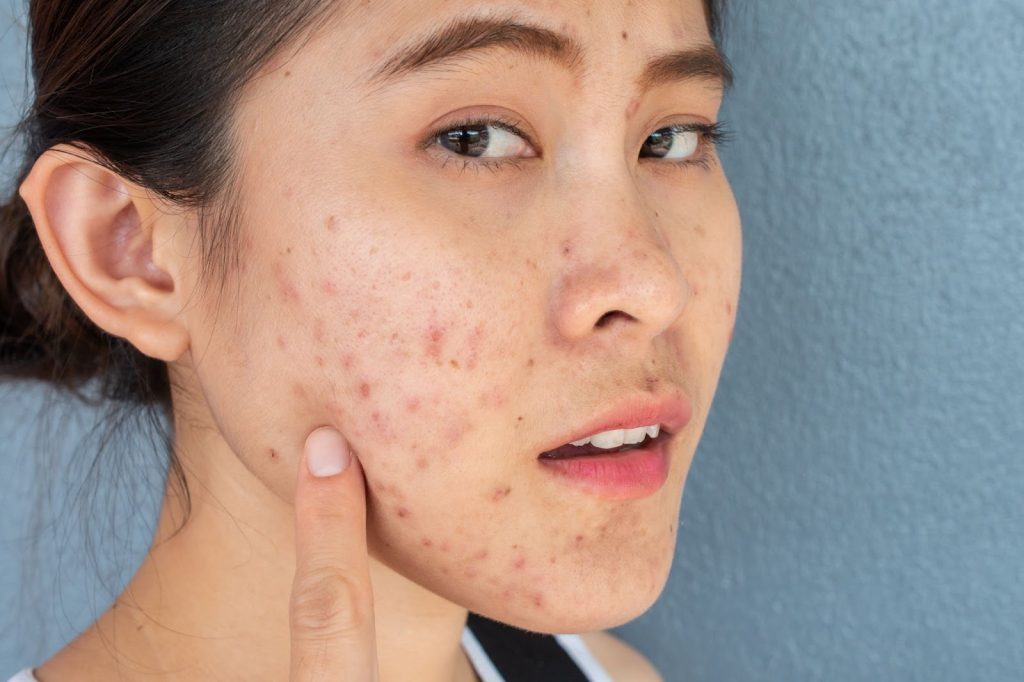What are acne scars?
Acne scars result from acne inflammation and they are commonly found on the face, chest, and back. In fact, approximately 80% of individuals between the ages of 11 and 30 years old will develop acne. At least one out of five of these people will then develop acne scars.
Reducing acne scars requires a combination of over-the-counter medications, medical treatments and effective skincare regimens.

Acne scars differ in appearance, from shallow, mottled depressions to deep and narrow depressions. There are various types of acne scars; these are:
- Atrophic scars: atrophic scars are the most common type of acne scars. They occur due to tissue loss or an underproduction of collagen during healing, which results in depressed or indented scars. There are three subtypes of atrophic scars:
- Rolling scars: rolling scars are characterised by broad, shallow indentations that give the skin a wavy texture. They are caused by damage beneath the skin's surface and often have sloping edges.
- Icepick scars: icepick scars are narrow, deep pits that extend into the skin's deeper layers. They resemble small holes or punctures and are typically caused by cystic acne.
- Boxcar scars: boxcar scars are broad depressions with sharply defined edges that resemble the scars left by chickenpox. They are usually wider than icepick scars and can vary in depth.
- Hypertrophic scars: hypertrophic scars are the opposite of atrophic scars. They are caused by an overproduction of collagen during healing, resulting in raised scars. Hypertrophic scars are typically found on the back, chest, and shoulders.
- Keloids: keloids are similar to hypertrophic scars in that they are an overproduction of collagen during healing. However, they extend beyond the acne or injury site. Keloids may appear red and raised and may continue to grow gradually.
- Erythematous scars: erythematous scars are red or pink marks that occur after acne. These tend to fade gradually.
- Post-inflammatory hyperpigmentation (PIH): post-inflammatory hyperpigmentation is dark spots that occur after acne. They are common in individuals with a dark skin tone and occur due to an overproduction of melanin.

What do acne scars look like?
Acne scars take on differing appearances depending on the type of acne scars. Some general signs or symptoms of acne scars include:
- Irregular texture: one of the most noticeable symptoms of acne scars is the uneven texture of the skin. Depending on the type of scar, the skin may appear pitted, indented, raised, or rough. Atrophic scars, such as ice pick, boxcar, and rolling scars, create depressions or indentations in the skin, while hypertrophic and keloid scars result in raised bumps or masses.
- Discolouration: acne scars can also cause changes in skin colour. Post-inflammatory hyperpigmentation (PIH) is a common symptom characterised by dark spots or patches of discolouration that remain after the acne has healed. Erythematous scars may appear pink or red due to persistent inflammation in the affected area.
- Pain or discomfort: some individuals with keloid or hypertrophic scars may experience pain or discomfort related to the scar. These scars, particularly keloids, may also feel tender and sensitive to the touch.
- Inflammation or redness: some scars, such as erythematous scars, are characterised by redness or inflammation. Certain factors, such as sunlight, may exacerbate the symptoms of these scars.
Who is at risk of acne scars in Singapore?
Not everyone who has acne will develop acne scars. There are several factors that increase an individual’s risk of developing acne scars; these include:
- Acne severity: individuals with severe or cystic acne are at a higher risk of developing acne scars than those with mild or moderate acne. Severe acne lesions penetrate deeper into the skin, increasing the likelihood of permanent scarring.
- Inadequate or delayed acne treatment: prompt and effective management of acne can help prevent the formation of deep lesions that are more likely to result in scarring. Delayed acne treatment increases an individual’s risk of scarring.
- Picking at pimples: while tempting, individuals must refrain from picking or squeezing pimples. Popping pimples can exacerbate inflammation and increase the risk of scarring.
- Gender: males are more prone to acne scarring than females.
- Genetics: some individuals have a genetic predisposition to acne scarring, and a family history of acne scarring increases the risk.
- Age: acne scarring is more common in older individuals, typically due to the skin’s reduced production of collagen and rejuvenating capabilities.

Are acne scars painful?
Acne scars are typically not painful, as they generally result from healed acne lesions and do not contain nerve endings. However, certain types of acne scars, such as hypertrophic and keloid scars, may cause discomfort or pain in some individuals.
Keloids can be tender to the touch and may cause sensations of pain, itching, or irritation. Due to their size, location, and tendency to become inflamed, keloid scars can be more painful than other types of acne scars in some cases.
How are acne scars diagnosed?
Acne scars are typically diagnosed visually by a qualified medical professional before a personalised treatment plan is developed.
- Medical history and physical examination: a detailed medical history will be obtained. This will help your doctor identify possible causes, treatment history, duration and severity of acne, and family history. A physical or visual exam is then conducted to assess the type and extent of scarring.
- Scar classification: scars are classified according to their distribution, type, and severity, which helps to guide treatment.
- Skin type assessment: your skin type may also be assessed to ensure that underlying skin conditions do not impact treatment outcomes. Individual factors such as skin tone, texture, and elasticity are considered when developing a personalised treatment plan for acne scars.
- Biopsy: if there are suspicious features around the scar, such as an evolving hypertrophic or keloid scar, your doctor may perform a skin biopsy (link to service page).

What are the treatment options for acne scars in Singapore?
Acne scars are often permanent, but treatment can help reduce or lighten scars. There is a wide range of treatment options available for acne scars in Singapore, depending on the severity and type of scarring. These include:
- Medicated creams and sunscreen: creams containing azelaic acid, salicylic acid, retinol, or hydroxyl acids may help lighten scarring. Using sunscreen can also help prevent acne scarring from getting worse.
- Punch excision: the scar is cut out using a small, cookie cutter-like punch tool and then stitched back together to create a less noticeable scar.
- Punch grafting: the scar is cut out using a small punch tool, and the hole is filled with a skin graft. The graft is usually taken from behind the ear.
- Chemical peels: chemicals are used to remove the damaged layer of skin and stimulate new growth. The CROSS (chemical reconstruction of skin scars) technique is a common type of chemical peel for ice-pick scars.
- Dermabrasion: in dermabrasion, a facial instrument is used to exfoliate the top layer of the skin, stimulating the body to produce collagen.
- Dermal fillers: dermal fillers are injected into the scar to help raise depressed areas of the skin, giving the skin a more even appearance.
- Laser and/or ultrasound therapy: lasers or ultrasound devices (link to service page) are often used to treat scarring by stimulating new skin tissue and collagen to form, improving the tone and texture of the skin. Repeated sessions may be required.
- Subcision: a small needle is wiggled back and forth underneath the skin to break up the fibrous strands. This process, typically for rolling scars, allows the skin to lift and look smoother.
- Corticosteroid injections: for raised scars, steroids can be injected into the scar tissue to flatten and soften the scar.
- Cryotherapy: cryotherapy is often used to treat keloid and hypertrophic scars, which involves freezing scar tissue that causes it to die and fall off.
- Surgical removal: some raised scars can be surgically removed, depending on your doctor’s advice.
- Microneedling: microneedling helps to improve skin texture by encouraging it to produce more collagen. Once stimulated, the collagen gradually smooths your indented acne scars from within.
In Singapore, it is important to seek out certified medical professionals to find a treatment plan that can help improve your skin’s appearance. Your doctor can also advise you on the dos and don'ts of preventing acne breakouts and recommend some lifestyle changes to help facilitate the treatment process. Contact us today (link to website) to book an appointment.
Frequently Asked Questions
Can acne scarring get worse?
Yes, acne scars can get worse with age. However, this is not the result of the scars worsening but rather due to your skin losing collagen and elasticity over time. As the skin loses collagen, the atrophic or depressed scars become more noticeable. Fat loss, especially around the temples and mid-cheek, may also accentuate the appearance of depressed scars.
Can I remove acne scars naturally?
Scars may fade naturally but are most likely not removable without medical treatment. Natural treatments may treat minor scarring but can also damage the skin further. Consult with your doctor if you plan to try any natural treatments.
How do you stop acne scars from forming?
If you wish to prevent scars from forming, it’s important to manage acne and breakouts. Using products with ingredients such as benzoyl peroxide or undergoing laser therapy may help. Contact your doctor for treatment options that can help prevent future acne scarring.

